
|
|
FYBUSH.COM/SITE OF THE WEEK
NEEDS YOUR SUPPORT! (AND YOU CAN GET A FREE TOWER SITE CALENDAR
IF YOU PLEDGE NOW...) CLICK HERE
TO LEARN MORE...
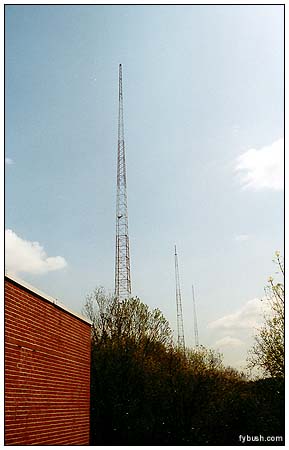 June
11-18, 2004
June
11-18, 2004
WRKO 680, Burlington, Mass.
Last week, we showed you pictures from our May visit to Boston's WEEI (850), the first stop on a long day of radio tourism in the Hub. This week, we head up route 128 to see WEEI's sister station, WRKO (680).
WRKO's history is one of the most interesting of any of Boston's radio stations. It can trace its legacy back to July 31, 1922 and the debut of WNAC, the radio voice of the Shepard department stores. By the time radio allocations settled down in the late twenties, WNAC had landed on 1230, where it was the flagship of the regional Yankee Network. With the great channel shift of 1941, WNAC ended up on 1260, operating with 5000 watts from a transmitter site south of Boston in Milton.
Meanwhile, 35 miles north of Boston in Lawrence, the Hildreth and Rogers newspaper interests (the Lawrence Eagle-Tribune) put daytimer WLAW on the air at 680 in 1937, initially running 1000 watts from a site in Andover.
WLAW had grander visions, though - after World War II, it migrated south, building a three-tower transmitter site in Burlington, only 15 miles or so northwest of Boston, and getting a CP to go to 50 kilowatts. From the new site, WLAW began identifying itself as "Lawrence and Boston," with new studios at the Hotel Bradford in Boston (in space just vacated by WBZ, which had built its own radio/TV facility out in Allston) and the CBS affiliation for the Boston market. WLAW even ventured into FM, using an antenna mounted atop the center tower of its AM array for WLAW-FM (93.7).
In 1953, WNAC bought the WLAW facility from Hildreth and Rogers, moving the WNAC calls and Yankee Network programming down to the more powerful signal at 680. WNAC's 1260 facility (along with the Hotel Bradford studios) were sold to Vic Diehm and Associates, which relaunched 1260 as WVDA. (It would later become WEZE for many years, and is today Radio Disney's WMKI.) Since WNAC already had a superior FM outlet on 98.5, the WLAW-FM license on 93.7 was surrendered and the frequency went silent for the rest of the decade. (93.7 would be resurrected in 1960 as the FM counterpart to WCCM 800 in Lawrence; it operated for many years as WCGY and is today, ironically enough, a sister station to WRKO under Entercom's ownership, playing rhythmic hits and oldies as "Star 93.7" WQSX. To this day, the pylon for the WLAW-FM antenna still sits atop the center tower of the 680 array.)
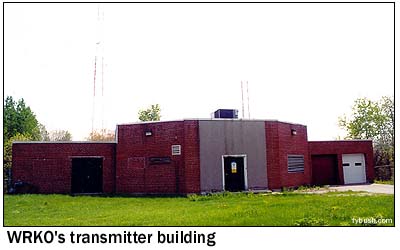 |
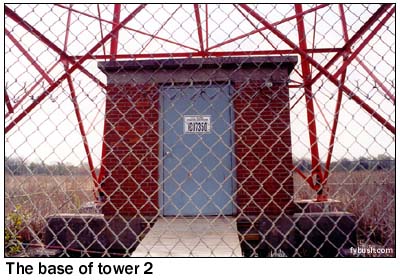 |
The Yankee Network and its stations eventually ended up in the hands of RKO General, and in 1967 RKO flipped sleepy old WNAC to WRKO, an aggressive, high-energy top-40 signal.
Right around that same time, the transmitter site out in Burlington went through an upgrade, and the oldest equipment now found out there - aside from the self-supporting towers themselves, 395' for the center tower, 440' for the outer two) dates from that era.
In 1981, as the golden age of AM top 40 drew to a close, WRKO dropped the music and went talk - and flourished again as the home to voices such as Jerry Williams and Howie Carr, not to mention many seasons with the Red Sox.
With RKO's loss of its broadcast licenses in a double-billing scandal, WRKO ended up in the hands of Atlantic Ventures, a forerunner of American Radio Systems, which brought WRKO and WEEI under a common roof. ARS was sold to Infinity, which then had to spin off WRKO and WEEI (and what was then WEGQ 93.7) to Entercom, which has owned the stations since 1998.
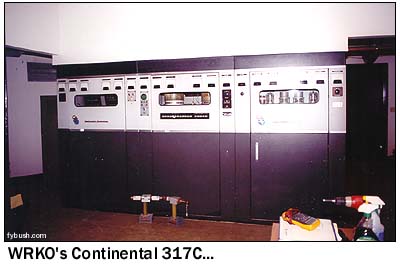 |
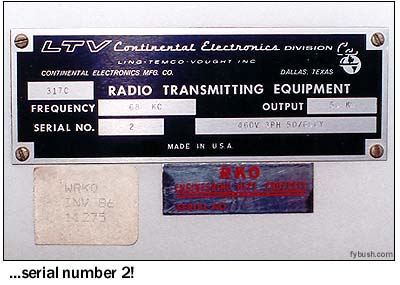 |
Walk in the door of the transmitter building (which bore a big "WRKO" sign out front for many years, though a letter or two went missing later on and eventually the remaining pieces were removed; today, a lone "R" in a closet inside the building is the last remnant) and look to your left and you'll see the transmitter that carried WRKO through its top-40 era. How early is this Continental 317C? As chief engineer John Kennedy proudly points out, it's serial number 2!
Behind the 317C is some open storage space, and behind that a door leads to a room that was at one time to have been the transmitter room for WEEI, when Entercom was contemplating moving it from its current Needham site to a diplex on the WRKO towers. That never came to fruition, and now the room holds furniture that's in storage from a succession of studio moves among the various Entercom properties (including the front desk from WAAF's old Westborough studios!)
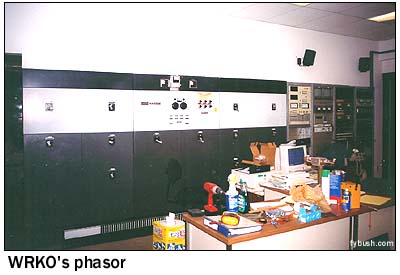 |
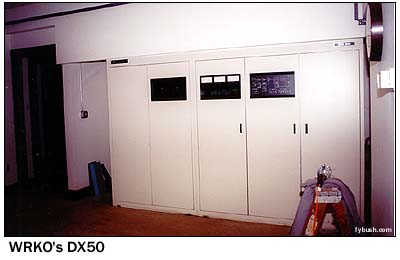 |
To the right of the 317C, in the center of the transmitter room, we see the phasor that was installed in 1967 when the site was rebuilt. (WNAC had used the same directional pattern day and night; in 1967, 680 went to DA-2 facilities, with a somewhat expanded day pattern.) At night, WRKO protects the primary occupant of 680, KNBR in San Francisco, and that means a deep null to the west-southwest. That wasn't a big deal in 1947 - or even in 1967 - when most of the population of the Boston market was still contained within Route 128 and the area around this transmitter site on Meadow Drive was, well, meadow. (It's still very quiet and peaceful down the rutted road that runs along the length of the widely-spaced array behind the transmitter building.) But today, WRKO's site is surrounded by one of the biggest shopping areas in New England and the suburbs of Boston sprawl far to the west of 128, far outside the coverage of 680's night signal.
To the right of the phasor sits WRKO's current main transmitter, a Harris DX50. A door to the left of the DX 50 leads down a hallway to the office area and, beyond it, a garage that's also used for storage.
Next week, we'll go up - and check out New England's most exciting rooftop!
Still haven't ordered? It's not too late - Tower Site Calendar 2004 is STILL AVAILABLE! If you haven't yet ordered, what are you waiting for? Click here for ordering information!
- Previous Site of the Week: WEEI, Boston
- Next Week: Prudential Center, Boston
- Site of the Week INDEX!
- How can you help support Site of the Week? Click here!
- Submit your suggestions for a future Site of the Week!
